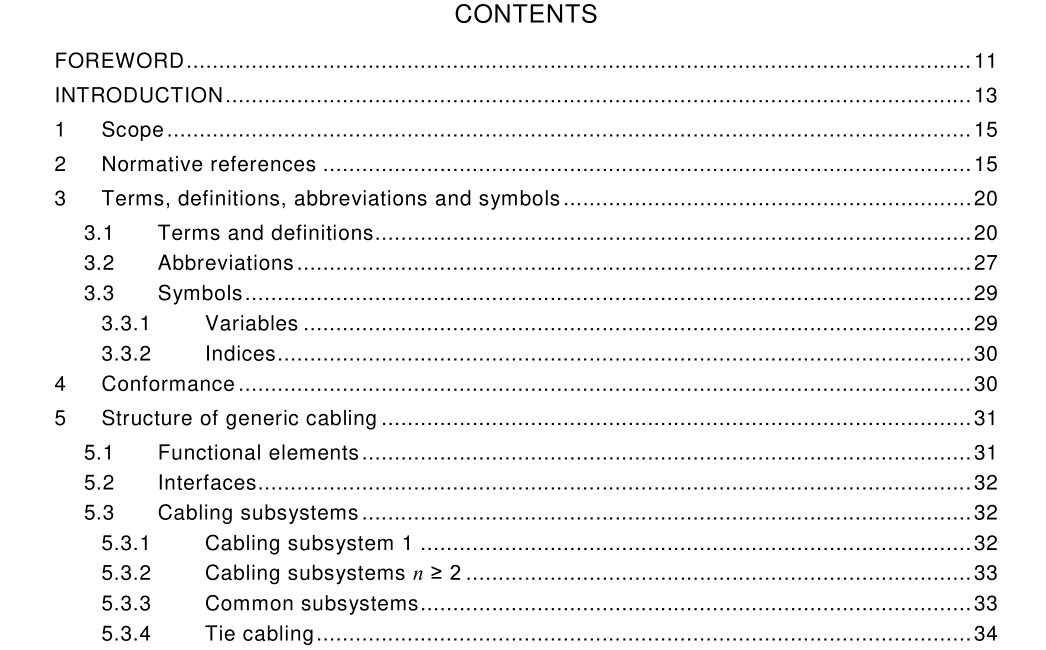ISO IEC 11801-1 pdf download.INFORMATION TECHNOLOGY – GENERIC CABLING FOR CUSTOMER PREMISES – Part 1 : General requirements
1 Scope
This part of ISO/IEC 1 1 801 specifies requirements that are common to the other parts of the ISO/IEC 1 1 801 series. Cabling specified by this document supports a wide range of services including voice, data, and video that may also incorporate the supply of power. This document specifies: a) the fundamental structure and configuration of generic cabling requirements within the types of premises defined by the other parts of the ISO/IEC 1 1 801 series, b) channel transmission and environmental performance requirements, c) link performance requirements, d) backbone cabling reference implementations in support of the parts of the ISO/IEC 1 1 801 series, e) component performance requirements, referring to available International Standards for components and test methods where appropriate, f) test procedures to verify conformance to the cabling transmission performance requirements of the ISO/IEC 1 1 801 series. NOTE This document does not contain specific conformance requirements. The cabling design documents supported by ISO/IEC 1 1 801 -1 incorporate the requirements of this document as part of their individual conformance requirements. In addition, this document provides information regarding the applications supported by the cabling channels.
3 Terms, definitions, abbreviations and symbols
3.1 Terms and definitions For the purposes of this document, the following terms and definitions apply. 3.1 .1 administration methodology defining the documentation requirements of a cabling system and its containment, the labelling of functional elements and the process by which moves, additions and changes are recorded 3.1 .2 alien crosstalk signal coupling from a disturbing pair of a channel to a disturbed pair of another channel Note 1 to entry: This also applies to the signal coupling from a disturbing pair within a link or component, used to create a channel, to a disturbed pair within a link or component, used to create another channel. Note 2 to entry: This is also known as exogenous crosstalk. 3.1 .3 alien far-end crosstalk loss signal coupling between a disturbing pair of a channel and a disturbed pair of another channel, measured at the far-end Note 1 to entry: This also applies to the measurement of the signal coupling between a disturbing pair within a link or component, used to create a channel, and a disturbed pair within a link or component, used to create another channel. Note 2 to entry: This is also known as exogenous far-end crosstalk loss. 3.1 .4 alien near-end crosstalk loss signal coupling between a disturbing pair of a channel and a disturbed pair of another channel, measured at the near-end Note 1 to entry: This also applies to the measurement of signal coupling between a disturbing pair within a link or component, used to create a channel, and a disturbed pair within a link or component, used to create another channel. Note 2 to entry: This is also known as exogenous near-end crosstalk loss. 3.1 .5 application system, including its associated transmission and power feeding method, which is supported by telecommunications cabling 3.1 .6 attenuation decrease in magnitude of power of a signal in transmission between points Note 1 to entry: Attenuation indicates the total losses on cable, expressed as the ratio of power output to power input. 3.1 .7 attenuation to alien crosstalk ratio at the far-end difference, in decibels, between the alien far-end crosstalk loss from a disturbing pair of a channel and the insertion loss of a disturbed pair in another channel Note 1 to entry: This also applies to the calculation using the alien far-end crosstalk loss from a disturbing pair within a link or component, used to create a channel, and the insertion loss of a disturbed pair within a link or component, used to create another channel. Note 2 to entry: This is also known as attenuation to exogenous crosstalk ratio at the far-end. 3.1 .8 attenuation to crosstalk ratio at the far-end difference, in decibels, between the far-end crosstalk loss from a disturbing pair of a channel and the insertion loss of a disturbed pair of the same channel Note 1 to entry: This also applies to the calculation using the far-end crosstalk loss from a disturbing pair within a link or component, used to create a channel, and the insertion loss of a disturbed pair within the link or component, of the same channel. 3.1 .9 attenuation to crosstalk ratio at the near-end difference, in decibels, between the near-end crosstalk loss from a disturbing pair of a channel and the insertion loss of a disturbed pair of the same channel
ISO IEC 11801-1 pdf download
